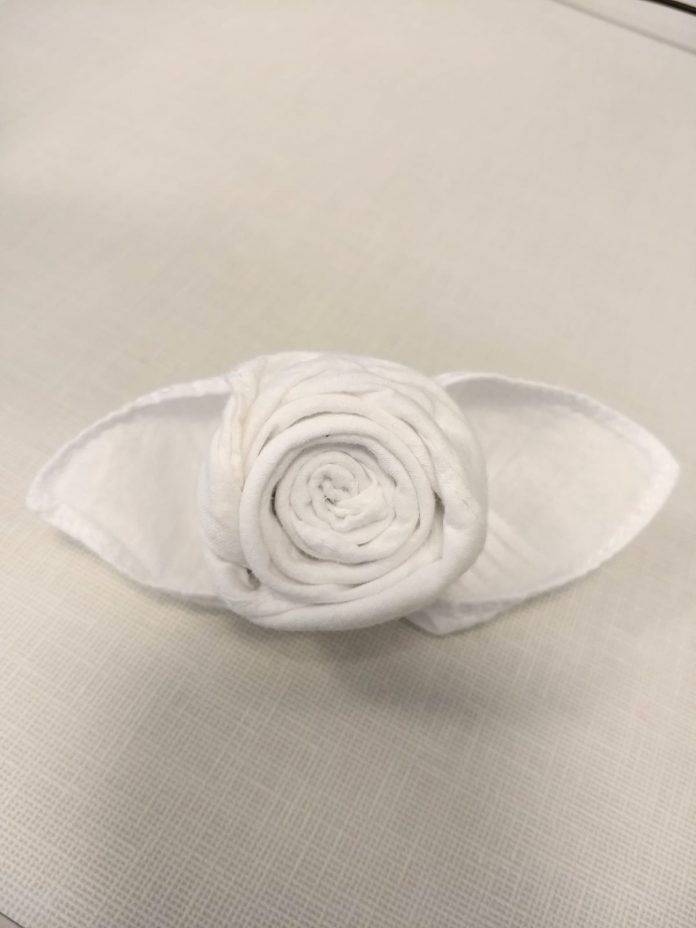Shayna Kronisch ’20 had been thinking about sewing for a long time. Every so often she would come across a crafting video and think, “Someday, I’ll do something like that.” She first began sewing a few months ago during winter break, and she was inspired by her family.
One type of project idea that inspired Kronisch is the concept of sewing new items out of the fabric from belongings that were special to her lost loved ones. She gives her creations to other family members.
“When my grandfather passed away over the summer, I thought it would be really nice if someone could make a stuffed animal out of some of his clothes for my grandmother,” said Kronisch. “Then over winter break, I was in a craft store and saw some fabric on sale. That’s when I decided it was time to start sewing.”
One of these family-focused projects, which she just completed, was a rose made out of Kronisch’s grandfather’s handkerchief for her cousin so that she would feel more connected to their grandfather on her wedding day. Other items Kronisch has sewn include an elephant (her first project), a teddy bear, a dinosaur and a cat silhouette. She is currently working on sewing a pillow with a red, paisley moon that has the shape of a howling wolf cut out of it.
“I know it sounds crazy, but it’s pretty cool. Once the pillow is done, I plan to start working on my grandmother’s teddy bear, the reason I started sewing to begin with,” said Kronisch.
Kronisch has never used a sewing machine and has been sewing all of her creations by hand. Her process for sewing a stuffed animal is as follows: she first takes fabric and folds it in half so that the back of the fabric is facing outward to both sides. Then, she puts safety pins in it to hold the fabric together, after which she uses a pencil to sketch the shape of the animal. She then cuts it out of both layers of fabric simultaneously, staying a little outside of the lines. Next, she takes a needle and thread and sews the two pieces of fabric together, on the lines this time; once she has sewn most of the way around, she turns the shell right-side-out. At this point, Kronisch attaches her embellishments such as buttons or other fabrics. Finally, she stuffs the shell through the remaining hole and sews it closed.
Kronisch has three favorite parts about the sewing process. “The first is how mentally and physically soothing it is to sew while listening in class; I guess it’s like my version of doodling. The second is that moment after I’ve turned the project right-side-out and stuffed it when I can finally see the finished stuffed animal,” she said. “The third is the excitement of looking at new fabrics and thinking about what I can do with them.”
Her three main challenges of sewing are trying not to get stabbed by what is supposed to be the dull end of the needle, dealing with thread-knots mid-stitch and attempting to stop loose-weave fabric from unraveling mid-project.
Kronisch has been able to connect her new hobby of sewing to her classwork. In one of the classes she is currently taking, Embodied Cognition, she has a long-term project to develop a skill and keep a weekly journal on her progress and first-person learning experience in terms of class concepts.
“This process has given me a much better understanding of myself as well as a way to personally apply what I learn,” said Kronisch.
Along with Embodied Cognition, Kronisch is able to connect her sewing to her Printmaking I course. In this class, she printed her most recent project on fabric in addition to paper so she could use it for future projects. She plans to stitch some of the fabrics with her print design on the backs of jackets, like a patch, and make others into pillows and possibly other things.
“I hope that, in this time of uncertainty, everyone can find something that brings them peace like sewing does for me,” said Kronisch.
Arielle Moss is a senior who majors in English and minors in Creative Writing and Philosophy. In addition to being Arts and Culture Editor, she is a member of the English Honor Society, Sigma Tau Delta, and the leadership honor society, Omicron Delta Kappa. On Fridays, you can find her enjoying Shabbat dinner at either Chabad or Hillel. After Muhlenberg, she dreams of attending graduate school with a goal of becoming an author of children’s literature.






















